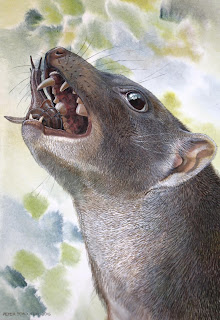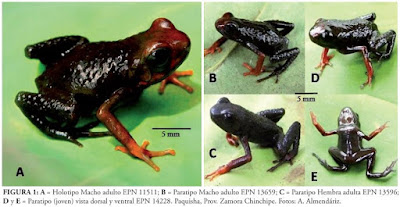[Most Recent Entries] [Calendar View]
Sunday, May 29th, 2016
| Time | Event | ||||
| 6:42a | [PaleoMammalogy • 2016] Malleodectidae fam. nov. • A New Family of Bizarre Durophagous Carnivorous Marsupials from Miocene Deposits in the Riversleigh World Heritage Area, northwestern Queensland, Australia
Abstract A new specimen of the bizarrely specialised Malleodectes mirabilis from middle Miocene deposits in the Riversleigh World Heritage Area provides the first and only information about the molar dentition of this strange group of extinct marsupials. Apart from striking autapomorphies such as the enormous P3, other dental features such as stylar cusp D being larger than B suggest it belongs in the Order Dasyuromorphia. Phylogenetic analysis of 62 craniodental characters places Malleodectes within Dasyuromorphia albeit with weak support and without indication of specific relationships to any of the three established families (Dasyuridae, Myrmecobiidae and Thylacinidae). Accordingly we have allocated Malleodectes to the new family, Malleodectidae. Some features suggest potential links to previously named dasyuromorphians from Riversleigh (e.g., Ganbulanyi) but these are too poorly known to test this possibility. Although the original interpretation of a steeply declining molar row in Malleodectes can be rejected, it continues to seem likely that malleodectids specialised on snails but probably also consumed a wider range of prey items including small vertebrates. Whatever their actual diet, malleodectids appear to have filled a niche in Australia’s rainforests that has not been occupied by any other mammal group anywhere in the world from the Miocene onwards. Systematic Palaeontology Subclass: Marsupialia Illiger, 1811 Order: Dasyuromorphia Gill, 1872 Family Malleodectidae nov. Included genera: Malleodectes Arena et al. (2011) Familial diagnosis: Medium-sized (~1 kg; see below), durophagous, carnivorously-adapted marsupials that differ from all others in the following combination of features: large, caniniform, laterally compressed C1; narrow, premolariform P1 adpressed against the base of C1; asymmetric P2 with wide, diamond-shaped (in occlusal view) posterior region, posteriorly-sloping crown and low, narrow, attenuated anterior region; uniquely (among known dasyuromorphians) large dP3 (similar in size to M1) with three cusps and a functional postmetacrista; enormous, subrounded, dome-shaped, essentially unicuspid, four-rooted P3 that is wider and longer than M1 and M2 (and probably M3), with (M. moenia) or without (M. mirabilis) a tiny cuspule near the posterior edge of the crown; M1 relatively (compared to M2) hypsodont, longer and wider than M2, with StB and StD directly buccal to the paracone and metacone respectively, StD taller than StB, a deep vertical fissure on the buccal flank of the crown, no anterior ectoloph crest, StE present on posterior ectoloph ridge, poorly-developed straight (M1) centrocrista and no posterior cingulum; M2 more conventionally dasyuromorphian-like with v-shaped centrocrista but with conules better developed than in most undoubted dasyuromorphians. Etymology: The family name derives from the type genus Malleodectes. Materials: In addition to specimens noted by Arena et al. (2011) we describe here QM F57925, juvenile cranial material including fragmentary left nasal and? frontal bones and a left maxilla with C1, P1, dP3, P3 crown (unerupted), M1–2, alveoli for P2 and M3. QM F57925 is from AL90 Site, a middle Miocene deposit that has been radiometrically dated as 14.64 ± 0.47 Ma old, and which contains a fauna correlating with mid- to late- Riversleigh Faunal Zone C17,18,19,27. AL90 has been interpreted to be a cave deposit, the original entrance of which acted as a natural pit-fall trap27,28,29. Estimated body mass: Using the “dasyuromorphian-only” dataset of Myers30, the most accurate regression equation that can be used to calculate body mass for Malleodectes mirabilis is the occlusal area of M2. This gives an estimated body mass (including the smearing estimate) of 896 g. Description of QM F57925, Malleodectes mirabilis QM F57925 is identified here as Malleodectes mirabilis and is differentiated from M. moenia based on the following features of P3: absolutely smaller; less rounded; lower-crowned; and lacking a posterior cuspule19. Comparison of P3 with that of the holotype of M. mirabilis (QM F50847) and that which Wroe12 originally referred to Ganbulanyi djadjinguli but which Arena et al. (2011) identified as M. moenia, was enabled through digital extraction of the unerupted P3 from micro-CT images (Fig. 3). All P3s referred here to species of Malleodectes are compared in Fig. 4. P3 of QM F57925 is 5.4 mm wide, 6.7 mm long and most closely approximates P3 in M. mirabilis (5.6 wide; 6.5 mm long) rather than the larger M. moenia (6.5 mm wide; 7.1 mm long).
Conclusion Although malleodectids are only known on the basis of partial upper dentitions, they clearly represent one of the most distinctive groups of marsupials yet discovered. Because they are known from such limited material and because of the many autapomorphic features they exhibit, relatively few of the preserved features clarify their phylogenetic relationships. The features that are available (most obviously, the larger size of stylar cusp D relative to stylar cusp B on M1–2), suggest, albeit tentatively, that malleodectids are dasyuromorphians. Our phylogenetic analysis confirms this assessment, placing Malleodectes within Dasyuromorphia in a polytomy that also includes dasyurids, thylacinids, the fossil forms Barinya and Mutpuracinus, and the sole known myrmecobiid Myrmecobius fasciatus. In terms of dental function, the well-developed molar dentition of Malleodectes suggests that it ate more diverse foods than just snails. The blades on the molars as well as the wear on anterior teeth suggest that small vertebrates were also part of the malleodectid diet. In combination, the large but laterally compressed C1, laterally compressed, delicate P1, hypertrophied, hammer-like P3 and tribosphenic molars with oblique shearing blades suggest that they occupied a niche in Australia’s Miocene rainforests that no other known mammalian group has managed to occupy since. M. Archer, S. J. Hand, K. H. Black, R. M. D. Beck, D. A. Arena, L. A. B. Wilson, S. Kealy and T.-t. Hung. 2016. A New Family of Bizarre Durophagous Carnivorous Marsupials from Miocene Deposits in the Riversleigh World Heritage Area, northwestern Queensland. Scientific Reports. 6, Article number: 26911. DOI: 10.1038/srep26911 Remains of bizarre group of extinct snail-eating Australian marsupials d... http://bit.ly/1WPDgSa via @UNSWnews @EurekAlertAAAS Derrick A. Arena, Michael Archer, Henk Godthelp, Suzanne J. Hand and Scott Hocknull. 2011. Hammer-toothed ‘marsupial skinks' from the Australian Cenozoic. Proc. Roy. Soc. B. 278, 3529–3533. DOI: 10.1098/rspb.2011.0486 http://blogs.scientificamerican.com/tetr | ||||
| 2:58p | [Herpetology • 2012] Excidobates condor • A New Species of Poison Dart Frog of the Genus Excidobates (Dendrobatoidea: Dendrobatidae) from the Cordillera del Cóndor, eastern Andes, Ecuador
ABSTRACT The genus Excidobates comprises two species, E. captivus and E. mysteriosus, distributed in the Río Marañón basin in Peru. Herpetofaunal assessments in the eastern Andean montane forest in Province of Zamora Chinchipe, Ecuador, resulted in the discovery of a new species of the genus, which we describe as Excidobates condor sp. nov. We provide information on habitat, natural history, and distribution, as well as describe its tadpoles. The species is known from three localities separated by 18 km (straight line distance) that generate a polygon of 7 km2. A phylogenetic analysis based on mitochondrial genes 12S and 16S rRNA suggests the new species is closely related to Excidobates mysteriosus and E. captivus, and is distinguished by color pattern and the texture of the skin of the dorsum. With the addition of the new species to Excidobates, none of the morphological characters diagnostic of the genus is synapomorphic. Thus, Excidobates is supported by genetic characters only. Additionally we analyze the morphological affinities between adults and larvae Andinobates abditus with members of the genus Excidobates. Key Words: New species; Dendrobatidae; Excidobates condor; Andinobates; Ecuador; phylogeny; ecological information. Ana Almendáriz C.; Santiago R. Ron and Jorge Brito M. 2012. A New Species of Poison Dart Frog of the Genus Excidobates (Dendrobatoidea: Dendrobatidae) from the Cordillera del Cóndor, eastern Andes, Ecuador. [Una especie nueva de rana venenosa de altura del género Excidobates (Dendrobatoidea: Dendrobatidae) de la Cordillera del Cóndor]. Pap. Avulsos Zool. 52(32); 387-399. DOI: 10.1590/S0031-10492012021200001. RESUMEN: El género Excidobates está conformado por dos especies, E. captivus y E. mysteriosus, distribuidas en la cuenca del Río Marañón en Perú. Evaluaciones de la herpetofauna del bosque montano oriental de los Andes de la provincia de Zamora Chinchipe en Ecuador, resultaron en el descubrimiento de una nueva especie del género, la misma que describimos como Excidobates condor sp. nov. Proveemos información sobre su hábitat, distribución y describimos sus renacuajos. La especie se conoce de tres localidades separadas por 18 km en línea recta y genera un polígono de 7 km2. Un análisis filogenético basado en los genes mitocondriales 12S y 16S rRNA sugiere que la especie nueva está cercanamente relacionada con Excidobates mysteriosus y E. captivus, de las cuales se diferencia por su patrón de coloración y la textura de la piel del dorso. Con la inclusión de la nueva especie en Excidobates ninguno de los caracteres morfológicos diagnósticos del género resulta sinapomórfico. Por lo tanto, Excidobates queda soportado solamente por caracteres genéticos. Adicionalmente se analiza las afinidades morfológicas entre los adultos y larvas de Andinobates abditus con los miembros del género Excidobates. Palabras-Clave: Especie nueva; Dendrobatidae; Excidobates condor; Andinobates; Ecuador; filogenia; información ecológica. Excidobates condor, nueva especie de ranita venenosa de la Cordillera del Cóndor, Ecuador! Pueden descargar el artículo aquí: http://bit.ly/Syntkc. Nueva especie descrita por los herpetólogos ecuatorianos Ana Almendáriz (EPN), Santiago Ron (QCAZ) y Jorge Brito (EPN) | ||||
| 3:19p | [Botany • 2013] Vanda perplexa • A New Species (Orchidaceae) from the Lesser Sunda Islands, Indonesia Summary Vanda perplexa, a new species of orchid from the Lesser Sunda Islands is described and discussed. Key Words. Blume, Indonesia, orchid, Rumphius, section Deltoglossa, Vanda furva. Vanda perplexa Motes & D. L. Roberts sp. nov. RECOGNITION. Affinity to Vanda limbata Blume but lacking a white margin to the petals and sepals, lip rectangular 12 – 14 mm wide (vs lip narrowly pandurate to 10 mm wide), column cylindrical (vs distinct thickening at base), inflorescence erect and compact (vs long and lax). DISTRIBUTION. Indonesia: Rinac, Komodo National Park; Bima on Sumbawa, western Nusa Tenggara. ETYMOLOGY. The specific epithet perplexa refers to the confusion the identity this taxon has created over the past 300 years. M. Motes and D. L. Roberts. 2013. Vanda perplexa (Orchidaceae): A New Species from the Lesser Sunda Islands. KEW BULLETIN. 68(2); 337-340. DOI 10.1007/S12225-013-9445-1 New orchid identified from Komodo http://phy.so/289636778 via @physorg_com | ||||
| 3:29p | [Botany • 2016] A Revision of Aeschynanthus (Gesneriaceae) in Singapore and Peninsular Malaysia ABSTRACT The genus Aeschynanthus Jack is revised for Singapore and Peninsular Malaysia. Four species for Singapore and fourteen species for Peninsular Malaysia are recognised, keys to the species are given, all names are typified, and detailed descriptions of all species are provided. Conservation assessments are provided for all species. Eleven names are lectotypified here and one epitype is designated. Keywords. Conservation assessments, Didymocarpoideae, identification key, lectotypifications Aeschynanthus albidus (Blume) Steud. Aeschynanthus angustifolius (Blume) Steud. Aeschynanthus dischidioides (Ridl.) D.J.Middleton Aeschynanthus fecundus P.Woods Aeschynanthus fulgens Wall. ex R.Br. Aeschynanthus longicaulis Wall. ex R.Br Aeschynanthus longiflorus (Blume) A.DC. Aeschynanthus obconicus C.B.Clarke in A.DC. & C.DC. Aeschynanthus pulcher (Blume) G.Don Aeschynanthus radicans Jack Aeschynanthus rhododendron Ridl. Aeschynanthus speciosus Hook. Aeschynanthus volubilis Jack Aeschynanthus wallichii R.Br. D.J. Middleton. 2016. A Revision of Aeschynanthus (Gesneriaceae) in Singapore and Peninsular Malaysia. Gardens’ Bulletin Singapore. 68(1): 1–63. |
| << Previous Day |
2016/05/29 [Calendar] |
Next Day >> |













